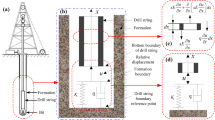Abstract
Control of blasting induced damage zone is one of the important topics in hydropower project construction, and the acoustic test method is commonly used to discriminate the blasting induced damage zone. However, the acoustic test results are usually affected by the geological conditions of the test site. During the traditional process of the acoustic test, water is usually injected into the test hole as a coupling agent. However, when the rock mass is abundant in joints, water leakage will appear, and thus the coupling water is in a flowing state. A large number of measured data indicate that when coupling water is in a flowing state during the acoustic test, the quality of the measured acoustic waveform will be worse than that in still water coupling, especially at the take-off point of the first waveform. The experiment results show that the acoustic waveform deterioration is mainly influenced by low-frequency interference, which is produced by pulsating pressure induced by flowing water. Furthermore, when the acoustic wave data is influenced by low-frequency interference caused by flowing water coupling, the take-off point of the first waveform will be more obvious while the acoustic wave data is filtered with appropriate frequency; as a result, the readability of the data will be enhanced and the accuracy of the acoustic test will be improved.












Similar content being viewed by others
References
Birch F (1960) The velocity of compressional waves in rocks to 10 kb, part 1. J Geophys Res 64:1083–1102
Blair DP, Siggins AF, Wold MB (1984) Stress sensitivity of seismic pulse velocity and rise time in a rock-like material. Int Rock Mech Min Sci & Geomech Abstr 21:219–221
Carranza-Torres C, Fairhurst C (1999) The elasto-plastic response of undergroundexcavations in rock masses that satisfy the Hoek–Brown failure criterion. Int J Rock Mech Min Sci 36:777–809
Feng GL, Feng XT, Chen BR et al (2015) Temperal-spatial evolution characteristics of microseismic activity for columnar jointed basalt tunnel at baihetan hydropower station. Chn J Rock Mech Eng 34:1–9 (in Chinese)
Gladwin MT, Stacey FD (1974) Aneleastic degradation of acoustic pulses in rock. Phys Earth Planet Inter 8:332–336
He HL, Ahrens TJ (1994) Mechanical propertied of shock damaged rock. Rcok Mech Min Sci 31(5):525- 533
Hu YG, Lu WB, Chen M et al (2014) Comparison of blast-induced damage between presplit and smooth blasting of high rock slope. Rock Mech Rock Eng 47:1307–1320
Jia JS, Yuan YL, Zheng CY et al (2010) Dam construction in China: statistics, progresses and concerned issues. Water Power 36(1):6–10 (in Chinese)
Luo Y, Li XP, Xu PC et al (2014) Characteristic study of surrounding rock mass deformation considering accumulative damage effect. Rock and Soil Mech 35(11):3041–3048 (in Chinese)
Ministry of Housing and Urban-Rural Development of People’s Republic of China (2014) Standard for engineering classification of rock masses. China Planning Press, Beijing (in Chinese)
Myung S, Chul SP, Byungho L et al (2012) Cross-hole seismic technique for a ssessing in situ rock mass conditions around a tunnel. Int J Rock Mech Min Sci 53:86–93
National Development and Reform Commission of People’s Republic of China (2007) Construction technical specifications on rock-foundation excavating engineering of hydraulic structures (DL/T5389–2007). China Water Power Press, Beijing (in Chinese)
Park KH, Tontavanich B, Lee JG (2008) A simple procedure for ground response curve of circular tunnel in elastic-strain softening rock masses. Tunn Undergr Space Technol 23:151–159
Read RS (2004) 20 years of excavation response studies at AECL’s underground research laboratory. Int J Rock Mech Min Sci 41(8):1251–1275
Serafim JL, Coutinho-Rodrigues JM, Zhang CQ (1989) World dam failure provisional statistics (1988). Large Dam and Safety Z1:139–149 Coring damage mechanism of the Yan-tang group marble: combined effect of stress redistribution and rock structure.
Yan CB (2006) Study on cumulative damage effects and stability of rock mass under blasting loading. Dissertation, Central South University, Changsha (in Chinese)
Yan CB, Xu GY, Yang F (2007) Measurement of sound waves to study cumulative damage effect on surrounding rock under blasting load. Chn J Rock Mech Eng 29(1):88–93 (in Chinese)
Yan P, Lu W, He Y, et al. (2015) Coring damage mechanism of the Yan-tang group marble: combined effect of stress redistribution and rock structure. Bull Eng Geol Environ 75:1701-1716
Yang XL, Yun XY, Wu Z et al (2001) Experimental study on mechanical properties of blasting damaged rock. Chin J Rock Mech Eng 20(4):436–439 (in Chinese)
Yueyang Aocheng Technology CO., LTD (2014) User manual for HX-SY02B (V1.2) non-metal acoustic meter. Changsha (in Chinese)
Zhang XL (2015) Collection of typical cases of dam failures and accidents at hydropower stations. Large Dam and Safety 1:13–16 (in Chinese)
Zhang YZ, Lu WB, Chen M et al (2013) Dam foundation excavation techniques in China: a review. J Rock Mech Geotech Eng 5:460–467
Acknowledgements
This work is supported by the National Science Fund for Distinguished Young Scholars of China (51125037), the National Key Basic Research Program (973 Program) of China (2011CB013501), the National Natural Science Foundation of China (51279135, 51279146) and the Fundamental Research Funds for the Central Universities (2014206020202). The authors wish to express their thanks to all supporters.
Author information
Authors and Affiliations
Corresponding author
Rights and permissions
About this article
Cite this article
Lu, W., Zhang, Y., Yan, P. et al. The influence of flowing water coupling condition on the result of rock mass acoustic test. Bull Eng Geol Environ 76, 1449–1459 (2017). https://doi.org/10.1007/s10064-017-1049-9
Received:
Accepted:
Published:
Issue Date:
DOI: https://doi.org/10.1007/s10064-017-1049-9




